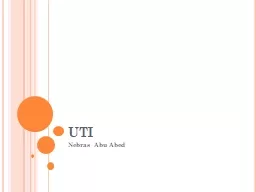

GENERAL CHARACTERISTICS Female VS male Prevalence in F Causes of this characteristic predominance Most common source of bacteremia caused by G organisms pathogens Most common IS ID: 929663
Download Presentation The PPT/PDF document "UTI Nebras Abu Abed Definition & CL..." is the property of its rightful owner. Permission is granted to download and print the materials on this web site for personal, non-commercial use only, and to display it on your personal computer provided you do not modify the materials and that you retain all copyright notices contained in the materials. By downloading content from our website, you accept the terms of this agreement.
Slide1
UTI
Nebras
Abu Abed
Slide2Definition & CLASSIFICATION
Slide3GENERAL CHARACTERISTICS
Female VS male
Prevalence in F ?
Causes of this characteristic predominance ?
Most common source of
bacteremia
caused by
G(-) organisms !
Slide4pathogens
Most common IS
E.Coli
….80%
Other organisms ???
Risk : men / recurrent UTIs /urinary
cath
Non –infectious causes of UTI symptoms ?
Radiation /
cytotoxic
drugs(
cyclophosphamide
)/interstitial cystitis
Slide5Risk factors
Gender
Certain birth control types
Pregnancy ???
Cath
Hx
of UTI
DM ??? Especially upper
Spinal cord injury??
Immunocompromised
Anything that impedes
urinanry
flow …BPH
Male risk
factos
(uncircumcised/ IC with male / IC with F carrying
uropathogens
)
Slide6COMPLICATED VS NON
Acute non-complicated : UTI in healthy non-pregnant ,pre-menopausal with no history of UT abnormalities .
Otherwise , considered complicated !
Ex : men, pregnant , diabetic , renal
faliure
,
Hx
of
pyelonephritis
,
cath
, AB resistant organism ,
immunocompromised
,recent
hospotalization
, recent AB exposure
Slide7Clinical features
Dysuria
… expressed ?
Frequency
Urgency VS hesitation
Tenderness …site ??
Sometime …gross
hematuria
What is characteristically ABSENT ?
Slide8diagnosis
1)Dipstick urine analysis
Look for
leuko
est
and nitrite
(+)
leuko
est
menas
?
(+)nitrites mean ?
Slide9Slide10diagnosis
2)Urinalysis
Clean catch midstream specimen ?
Criteria :
*
Bacteruria
: >1 organism/oil immersion field
Bacteruria
without
pyuria
isn’t reliable
*
pyuria
: greater than or equal 10
leuko
/micro L
Slide11Urine culture
Acute non complicated ??
Indicated in :
1)Asymptomatic
bacteruria
???
When diagnosed ?
In which patients ???
2) Suspected
pyelonephritis
, complicated , recurrent UTI , suspicion of resistant organism
*criteria : >= 10^5 CFU/
mL
, 2 to 4 is enough if symptoms & signs are present !
Slide12Complications
1)Upper spread (
pyelonephritis
/
prostaties
/
urosepsis
)
Risk factors : pregnancy , DM , VUR !
2)During pregnancy : preterm labor , LBW .
3)Recurrence
Slide13Treatment
In acute uncomplicated :
Bactrim
3 days ( oral TMP/SMX) &
Nitrofurantoin
5-7 days
We can also use :
fosfomysin
single dose or
Fluroquinolones
(
cipro
3 D regimen )
Urinary analgesic :
phenazopyridine
1-3 days
Don’t use
nirtofurantoin
or
fosfomycin
if PN is suspected !!
If didn’t respond for short AB , treat for PN
Slide14Treatment
Pregnancy :
Amicillin
, amoxicillin or oral
cephalosporins
for 7-10 days
Avoid
fluoroquinolones
, fetal
arthropathy
Slide15treatment
Men : as in uncomplicated but for 7 days
Slide16Pyelonephritis
Farah al-
hjouj
Slide17Organisms :
e.Coli
G(-) :
proteus
,
klebsiela
,
enterobacter
,
psudomonous
G(+) :
s.aureus
Slide18Clinical features
Symptoms ???
Signs ???
Slide19Diagnosis
1)Urinalysis
2)Urine culture
3)Blood culture
4)CBC
5)Renal function
6)imaging
Slide20complications
1)Sepsis
2)
Emphesematous
PN
3)Chronic PN
Slide21Treatment ?????